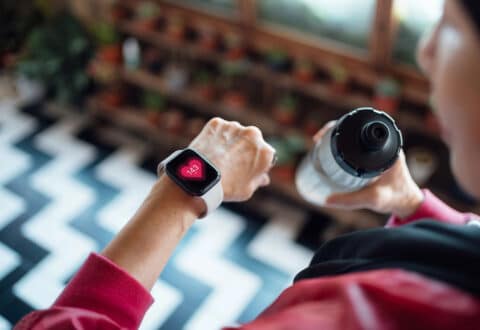Social media marketing in the wellness industry is an effective tool to achieve a variety of organizational goals — develop credibility, build trust, improve communications and attract more patients and customers.
While social media is the venue in which these goals can be accomplished, social media strategy is how it all comes to fruition. A personalized social media strategy identifies and considers your target audiences, creates a strategic framework to tailor communications, and relies on a content value exchange to ensure your message resonates and leads to action. Read on for everything you need to know about how to leverage social media marketing in the health and wellness industry.
The Role of Social Media in the Healthcare and Wellness Industry
Social media marketing leverages content via social media platforms and paid social media advertising to boost brand recognition, raise awareness, reach target audiences, share new treatments and promote innovative technologies and products. In the wellness industry, social media marketing is one of the most cost-effective distribution tools for healthcare information and a key opportunity to gather real-time research and insights, and support patients and the public through an accessible and timely platform.
Research confirms that U.S. social media users are interested in receiving health information through social media. According to a 2010 survey, 80% of U.S. Internet users have searched for health information online, and 60% of social media users trust social media posts by doctors over any other group. By engaging and interacting on the social media platforms that their patients frequent, health systems can revitalize their word-of-mouth referrals, improve communication, and provide better care by ensuring that patients continuously engage with the health system.
4 Benefits of Social Media Marketing For Your Health and Wellness Business
Social media marketing offers a variety of benefits for health and wellness brands. Once a strategic, cohesive and targeted social media presence and plan are executed, a spectrum of overall business goals can be achieved — from health and fitness pr success to social media lead generation. Check out these common benefits:
1. Navigate Health and Wellness Crises
In today’s digital world, many consumers use social media as a news source for current events — . and the COVID-19 pandemic was no exception. Savvy health and wellness brands leveraged social media marketing strategies during this time to share key safety guidelines, tips and statistics to effectively increase social media engagement and website traffic.
2. Raise Community Awareness
Its timely and accessible nature makes social media an effective way to raise public awareness about new health concerns and emerging technologies and products. It can also be a useful tool for healthcare PR campaigns to target specific audiences and population groups.
3. Disseminate Health and Medical Information Quickly
The internet is full of insufficient medical information, which is unfortunately consumed and internalized by many healthcare patients around the globe. Strategic healthcare communications can have the power to disseminate the accurate and actionable medical information people need to lead healthy lives.
4. Combat Health and Wellness Misinformation
While social media’s timely and accessible nature is helpful, it can also be harmful when it comes to misinformation. From untrue statements to misleading statistics, health and wellness information from credible and reputable sources has never been more important.
Social Media Marketing Strategies For Boosting Digital Presence in the Wellness Industry
Did you know there are currently 3.5 billion and counting social media users today? That’s roughly 45% of the global population, which means health and wellness organizations are missing a spectrum of digital content marketing opportunities if they aren’t properly leveraging social media.
Not sure where to start? These tried-and-true wellness marketing strategies will help you stand out in a saturated space, avoid common mistakes and achieve your goals faster.
Put Patients First
Who is your ideal patient, customer or client? How old are they? Where do they live? What are their interests? Fully understanding your target audience is the first step in developing a successful social media marketing strategy. Once you understand who you are talking to, you can tailor your strategy and tone to the benefit of the user, not your organization.
Collaborate with Health and Wellness Micro-Influencers
Health and wellness is all about people, which is why influencer marketing is an incredibly effective strategy for this industry. Influencer marketing harnesses the power of influencers to promote a brand, product and/or message to a larger market. Opinion leaders with robust social media accounts, health and wellness influencers offer expertise or trustworthy information that can amplify your brand to your target audiences, produce authentic storytelling and achieve your organization’s business goals.
Healthcare organizations can also promote their own medical influencers and other influential people in healthcare to provide credible people to speak on medical topics.
Provide Patients (or Clients) with Educational Content
From FAQs for common illnesses and daily health tips to free resources for patients, providing educational content is a powerful way to teach and engage social media followers in the health and wellness industry.
Highlight Patients’ Mention (Reviews) to Spread Positivity
Testimonials and online reviews are incredibly helpful in establishing credibility for health and wellness organizations. Be sure to promote and respond to online reviews to humanize your brand and amplify your efforts.
Engage With Your Patients (or Clients) and Community
Chances are you’re familiar with several types of social media, but not all of them. Discover the many different ways social media can help your healthcare or wellness organization target key audiences and effectively share your message.
Explore a Variety of Social Networking Sites
As social networking has evolved, medically focused professional communities have been established. These networks are often private and protected from nonmembers, such as the lay public and even members of other health professions. Funding sources for these sites vary, with financial support often being provided by professional associations, advertising or data sales, research funding, and pharmaceutical companies.
Leverage Blogs
Blogs offer an opportunity to share short or long-form content in a variety of media, such as text, video and audio, to a wide reach of audiences about a specific topic of varied interests. Popular blog content can be shared to establish brand reputation and promote your organization’s online presence.
Use Hashtags and Tweets
The most dynamic and concise form of information exchange via social media, microblogs allow users to post a large number of brief messages or updates over a short period. Twitter is the most popular microblog platform. Microblog hashtags allow information to be properly tagged and easily found by interested users, such as the topic discussed or a conference or event.
Publish on Wikis
Public forum websites featuring text and multimedia content that can be edited by users, Wikis are popular due to their prominence in Google searches. Wikipedia is the most commonly used wiki in the medical community and is often referenced by clinicians. Despite its potential errors and narrow breadth of information, if your target audience is utilizing Wikipedia, so should your organization.
Harness Media-Sharing Sites
Media-sharing sites, such as YouTube, can be important resources for education, community building, marketing, and branding — especially among health and wellness audiences.
Consider Virtual Reality and Gaming Environments
Three-dimensional environments that allow users to interact with each other through a virtual representation of themselves, or an avatar, multi-user virtual environments (MUVEs) are growing in popularity in the healthcare industry for patient education and clinical learning opportunities.
The Dangers of Social Media in the Health and Wellness Industry and How to Reduce Them
While social media offers a variety of benefits for health and wellness organizations, it’s also important to be aware of — and avoid — some of the related dangers. Once you and your team are fully educated about what could go wrong, you can reduce risks and even have action plans in place if needed.
Guidelines for The Use of Social Media in Health and Wellness Institutions
From inaccurate information and patient privacy breaches to licensing issues and legal problems, explore the following guidelines to reduce risks related to social media for your health or wellness organization.
Healthcare Institutions Guidelines for Social Media Use
Consult the following guidelines to navigate the use of social media for your healthcare organizations related to safety and security of patient information, patient consent, employment practices, physician credentialing and licensure, the violation of HCP–patient boundaries and other ethical issues.
| Context | Concept |
|---|---|
| Content credibility | Share only information from credible sources. Refute any inaccurate information you encounter. |
| Legal concerns | Remember that the content you author may be discoverable. Comply with federal and state privacy laws. Respect copyright laws. |
| Licensing concerns | Know professional licensure requirements for your state. |
| Networking practices | Do not contact patients with requests to join your network. Direct patients who want to join your personal network to a more secure means of communication or to your professional site. |
| Patient care | Avoid providing specific medical advice to nonpatients. Make appropriate disclosures and disclaimers regarding the accuracy, timeliness, and privacy of electronic communications. |
| Patient privacy | Avoid writing about specific patients. Make sure you are in compliance with state and federal privacy laws. Obtain patient consent when required. Use a respectful tone when discussing patients. |
| Personal privacy | Use the most secure privacy settings available. Keep personal and professional profiles separate. |
| Professional ethics | Disclose any in-kind or financial compensation received. Do not make false or misleading claims. |
| Self-identification | Identify yourself on professional sites. Make sure that your credentials are correctly stated. Specify whether or not you are representing an employer. |
Table source: www.ncbi.nlm.nih.gov
Examples of Successful Health and Wellness Brands Utilizing Social Media
Searching for the best health and wellness social media campaigns? Discover how the following examples of wellness marketing strategies can inspire your social media marketing to grow followers, acquire leads and customers and boost audience engagement.
Prism Health
Supporting the LGBTQ community in Portland, Oregon, and beyond, Prism Health explicitly advertises to a patient group that is often overlooked in the healthcare space. Their social media focuses on inclusive branding, such as the use of pronouns for providers, and relies on compassionate, personalized content to reach their target audience.
Baylor Scott & White
As the largest not-for-profit healthcare system in Texas, Baylor Scott & White utilizes a variety of social media channels. Their Twitter account posts multiple times each day about healthy habits, new research and current events, and has become a trusted health and wellness resource. Its Twitter feed covers top-of-mind issues for healthcare audiences, such as the importance of flu vaccinations, to effectively resonate with their current and prospective patients.
Cochlear
When Cochlear Americas, the global leader in implantable hearing solutions, needed a cohesive social media strategy for its many active channels, it turned to an experienced wellness marketing agency. Communications Strategy Group (CSG®) analyzed the global brand’s robust social media accounts and online audiences to understand why it wasn’t translating social media leads and conversions and developed a HealthTech-focused social media marketing strategy to extend Facebook and Twitter reach, increase engagement, educate people about advanced hearing solutions and connect with candidates who could benefit from its products. The multifaceted approach included solidifying the social presence, identifying the target audiences, creating a strategic framework and curating a monthly social content calendar, which resulted in a 2,500% increase in Facebook- and Twitter-driven leads, 703,891 engaged social media users and 16,296 average monthly website visits from social.
FAQs About Marketing Wellness Brands
What Are Effective Social Media Wellness Marketing Strategies For Attracting New Customers?
Leverage the social media platforms that your potential customers are most active on and create powerful content that resonates to convert them from social media followers to real-life leads.
How Has Social Media Influenced the Marketing of Healthcare and Wellness Products?
Social media has leveled the playing field by allowing healthcare and wellness businesses — regardless of size or budget — to market products, join the current health conversation and reach key online audiences.
Are You Ready To Reach Your Social Media Marketing Potential?
With the right strategy and expertise, social media is an incredibly powerful marketing tool for health and wellness businesses. Armed with a spectrum of social media campaign expertise in the health and wellness industry, CSG can help you bolster social media lead generation.
Whether you are trying to get your message in front of a new audience, reach potential customers, build brand reputation or introduce a new product or service, the right healthcare marketing agency can help you achieve your goals.
Contact us today to discover how our wellness marketing services can take your social media strategy to the next level.


